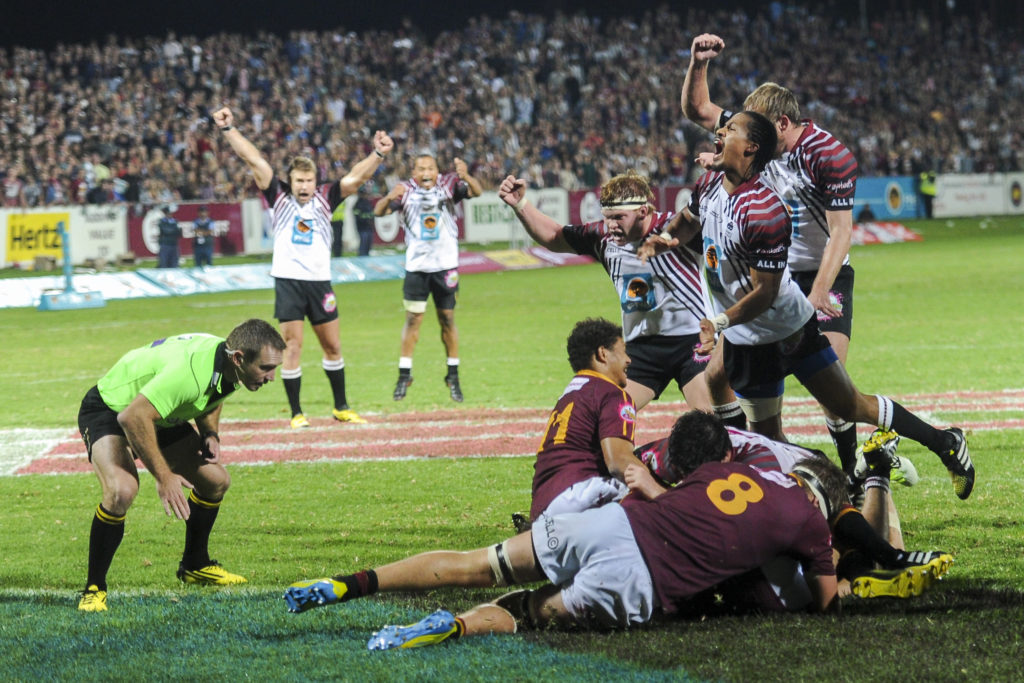The Varsity Cup numbers are in and it’s clear that, despite sometimes comedic attempts to reshape the game, rugby is resistant to change, writes ZELIM NEL.
The Varsity Cup has been fantastic for rugby, ramming home the delightful truth that the game is an obstinate beast and, quite frankly, it doesn’t give a damn about marketing gimmicks.
Years into a sales mission aimed at cancelling scrums, legalising forward passes and generally turning rugby into a carnival of friendly ankle taps and appealing offloads, the Varsity Cup was born in 2008 and the competition has since left no stone unturned in the quest to tilt the balance of the rugby contest away from defence and toward attack.
The list of try incentives includes some real pearlers. Remember the innovation downgrading penalties to two points, and allowing teams to send off two players from the opposing team for 10 minutes?
The past couple of seasons have been played under tweaks that increase the value of a try to seven points when said try originated from possession on the other side of halfway, while kicking has been discouraged by allowing receivers to mark the ball anywhere on the field.
Based on competition data from the 2021 season to date, the innovations have not had the desired result.
After six rounds of action, UCT top the table with five wins and 26 log points, followed by Tuks, CUT and Maties. The bottom four on the 10-team ladder are last-placed Madibaz, below Wits, Shimlas and UJ respectively, while NWU and UWC occupy mid table.
While Ikeys have scored the most tries in the comp, averaging 5.2 per match, Wits are tied second for try-scoring and they’re languishing in ninth place.
UCT also lead with an average of 10.5 offloads, but again any hope that the Varsity Cup had unlocked a contest where offloads are king is dashed by the fact that CUT have made a competition-low 28 offloads in six matches and yet they’re five places higher than Madibaz, who have dared to dazzle with 48 offloads.
What about linebreaks, surely? Nope. Eighth-placed Shimlas lead with 12 breaks, Tuks have been credited with only two.
Admittedly, all stats categories are connected and there is no one magic stat that can be mastered to guarantee success. But there are obvious trends common to winning teams and unfortunately the data does not support the notion that holding on to the ball is a key indicator of success.
Five teams have made more carries than the log leaders, Maties chief among them with an average of almost 100 carries per game – a fact CUT exploited to make almost 200 tackles in their maiden victory over the Stellenbosch juggernaut.
So, how have UCT averaged more than five tries per game with a low-volume attack that averages 50 carries per linebreak? The answer is a four-letter word: kick.
The Ikeys, whose slogan is ‘Running Rugby since 1882’, are top of the log because their plan is based on the proven recipe of beating the defensive wall with kicks, not carries.
Flyhalf James Tedder looks pro-ready in a UCT system that has fired an average of 24.3 kicks per game for a total of 146 kicks from hand in six matches. The efficacy of prioritising field position over possession is confirmed by the fact that a ranking of the teams by their kick volume almost exactly mirrors the Varsity Cup standings.
Shimlas and Madibaz combined have kicked less than the Ikeys and they occupy the last two spots on the table.
The top-five kicking teams collectively average 79 carries per game and boast a points difference of +58. The bottom-five kicking teams average 77 carries per game and have an average points difference of -58.
The disparity in points can be explained by, among other things, the top five putting boot to ball at a rate of 20 kicks per game while the bottom five only launch 14. The front-runners contest possession beyond the halfway line where the bottom feeders are quite content hogging possession in the shadow of their uprights.
This has proven to be true since analysts first started collecting data on rugby. It remains true in the 2021 Varsity Cup.
— stats provided by Mobii Analytics




